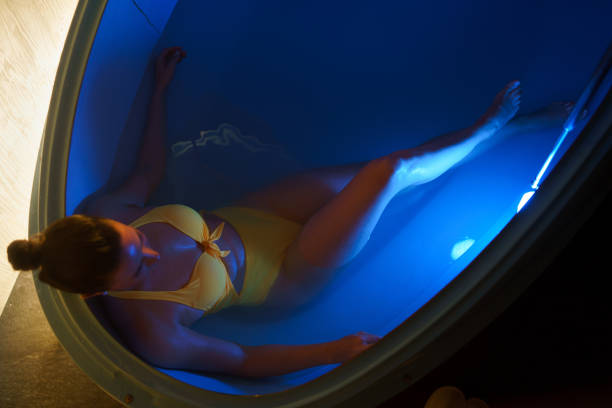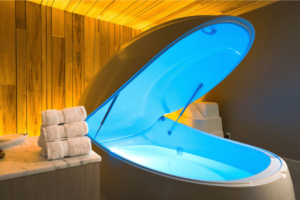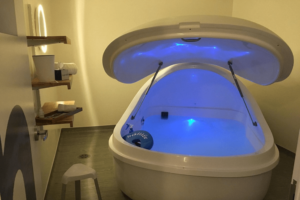In today’s fast-paced world, where stress and burnout are becoming more common, taking time to relax and recharge is essential for maintaining a healthy mind and body. One of the most innovative ways to achieve this is through float therapy sessions. Often referred to as sensory deprivation or floatation therapy, this technique offers a unique way to disconnect from the outside world, ease mental and physical stress, and restore balance to your body.
In this blog post, we’ll explore everything you need to know about float therapy and how it can help you achieve ultimate relaxation and rejuvenation.
What Is Float Therapy?
Float therapy involves floating in a special tank, often called a sensory deprivation tank or floatation pod, filled with warm water that contains a high concentration of Epsom salt. The high salt concentration allows you to float effortlessly, creating an experience that mimics the sensation of weightlessness. The tank is designed to block out external stimuli such as light, sound, and touch, offering a tranquil environment where you can relax, meditate, or even sleep.
How Does Float Therapy Work?
Floatation therapy works by immersing your body in a deep state of relaxation and sensory deprivation. The water in the tank is heated to skin temperature (around 93.5°F or 34°C), and the Epsom salt concentration is so high that it allows your body to float effortlessly on the surface.
This combination of warm water and buoyancy provides an environment where external distractions are minimized, allowing your body to enter a deeply relaxed state. This lack of external stimuli encourages your mind to slow down, helping you disconnect from the stress and clutter of everyday life.
The Many Benefits of Float Therapy
Floatation therapy offers a wide range of physical and mental benefits, making it an excellent option for anyone looking to relax, recharge, and promote overall well-being. Here are some of the most notable advantages:
1. Reduces Stress and Anxiety
One of the primary benefits of float therapy sessions is its ability to reduce stress and anxiety. The deep relaxation induced by floating in a sensory deprivation tank triggers a decrease in cortisol, the body’s stress hormone. This helps calm the nervous system and alleviate feelings of anxiety, allowing you to feel more at peace.
2. Improves Sleep Quality
For those struggling with insomnia or poor sleep quality, floatation therapy offers a natural remedy. As your body enters a state of profound relaxation, it helps regulate your circadian rhythm and promotes the release of endorphins and serotonin. These “feel-good” chemicals improve your mood and encourage restful sleep.
3. Alleviates Muscle Tension and Pain
The buoyancy created by the saltwater in a sensory deprivation tank takes the pressure off your joints and muscles, allowing them to fully relax. This can be particularly beneficial for people suffering from chronic pain, fibromyalgia, or sore muscles after a workout. Many individuals report experiencing less muscle tension and increased flexibility after just one float session.
4. Enhances Creativity and Focus
By shutting out external distractions, floatation therapy allows your brain to enter a meditative state. This can lead to increased creativity and enhanced focus, making it ideal for entrepreneurs, creative professionals, or anyone looking to boost their productivity. Many people use float therapy sessions to brainstorm ideas or work through mental roadblocks.
5. Promotes Mental Clarity and Emotional Balance
The calm, quiet environment within the sensory deprivation tank encourages deep introspection and mindfulness. It can help clear your mind of negative thoughts, allowing you to achieve mental clarity and emotional balance. This can have lasting effects, promoting a sense of well-being and a more positive outlook on life.
6. Detoxifies the Body
The Epsom salt used in the floatation tanks has detoxifying properties that can help flush out toxins from your body. Epsom salt is known for its ability to draw out impurities, which can contribute to improved skin health, better circulation, and overall wellness.
How Can Float Therapy Help You Recharge?
Floatation therapy isn’t just about relaxing; it’s about recharging your body and mind. For many people, the demands of modern life—whether at work or at home—can leave them feeling drained and exhausted. Here’s how float therapy can help you recharge:
1. A Complete Disconnect
In today’s digital age, we are constantly connected to our devices, which can lead to mental fatigue. Float therapy offers a complete break from technology, allowing you to disconnect from the world and focus on yourself. This mental reset can leave you feeling more energized and ready to face life’s challenges.
2. Increases Energy Levels
After a floatation therapy session, many people experience a noticeable boost in their energy levels. The deep relaxation helps your body recover from physical exertion and stress, leaving you feeling refreshed and invigorated.
3. Provides Time for Self-Care
Taking time for yourself is essential for maintaining good health, both physically and mentally. Floatation therapy allows you to set aside time for self-care, providing a peaceful environment where you can relax without distractions.
How Often Should You Try Float Therapy?
While one session can provide relaxation and relief, the true benefits of floatation therapy are often realized with regular practice. Many individuals find that visiting a floatation center once a week helps maintain their mental and physical well-being. However, the frequency of your float therapy sessions depends on your personal goals and needs.
Some people may find relief from pain, stress, or anxiety after just a single session, while others may benefit from multiple sessions spread out over weeks or months.
Is Float Therapy Right for You?
Floatation therapy is a safe and effective way to relieve stress, enhance focus, and promote overall health. However, it’s important to note that float therapy may not be suitable for everyone. People with certain medical conditions, such as severe claustrophobia, open wounds, or skin conditions that are aggravated by salt, should consult with a healthcare professional before trying float therapy.
What to Expect During a Floatation Therapy Session?
When you first arrive at a floatation therapy center, you will be given instructions on how to use the sensory deprivation tank. Most sessions last between 60 and 90 minutes. During this time, you will float in a quiet, dark tank, allowing your body to fully relax. The water will be warm and comfortable, and you will experience the sensation of weightlessness as the buoyancy of the water supports your body.
Conclusion
Float Therapy provides an innovative way to disconnect from the daily grind and truly relax and recharge. Whether you are looking to reduce stress, alleviate muscle pain, or enhance your mental clarity, a floatation therapy session offers an experience unlike any other. If you’re ready to experience the rejuvenating benefits of float therapy, consider visiting Secret Soak Society, a leader in providing high-quality floatation sessions guidance.
By prioritizing your mental and physical well-being, floatation therapy offers a simple yet powerful way to improve your quality of life and enjoy lasting benefits for your health and happiness.
Float Therapy FAQS
How long does a floatation therapy session last?
A typical floatation therapy session lasts between 60 and 90 minutes, though longer sessions may be available at some centers.
Can I float if I’m pregnant?
Many pregnant women report feeling great relief from back pain and stress during floatation therapy. However, it’s always best to consult your doctor before trying float therapy during pregnancy.
Will I feel claustrophobic in the tank?
The tanks are large enough to allow you to stretch your arms and legs. Most people do not feel claustrophobic, but if you do, you can leave the lid open during the session.
Is floatation therapy safe?
Yes, floatation therapy is generally considered safe for most people. However, it’s important to consult your doctor if you have any concerns about your health before trying it.
How does float therapy compare to a traditional spa experience?
While both offer relaxation, float therapy provides a deeper level of mental and physical rest due to the sensory deprivation and buoyancy of the water.





